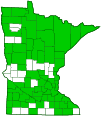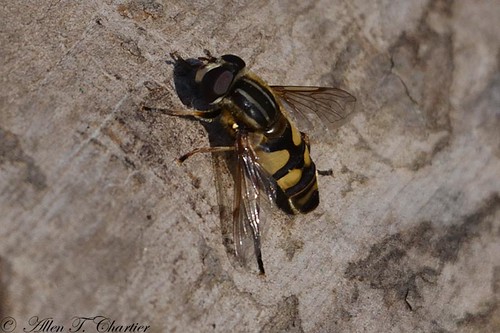narrow-headed marsh fly
(Helophilus fasciatus)
Conservation • Description • Habitat • Ecology • Distribution • Taxonomy
|
|
|||||||||||||
Description |
Narrow-headed marsh fly is a robust, medium-sized, ⅜″ to ⅝″ long hoverfly. It is somewhat bee-like in appearance. The head is rounded in the front, not flattened. There is a shiny, orange, vertical stripe on the front on the face. There are two large compound eyes and three very small simple eyes (occelli). The compound eyes of the male, like the female, do not meet at the top of the head, and are narrowed abruptly at the top of the face. On the female the margin is straight. This gives the male a much narrower area between the compound eyes at the top of the head (vertex). The occelli are are arranged in a triangle on the vertex. On the female the vertex and upper part of the face (frons) are completely covered with short black hairs and are narrower than the width of the pair of tubercles that bear the antennae (antennal process). The antennae are short. The thorax is brownish-black with four longitudinal stripes. The two middle (dorsal) stripes are white, whitish, or pale yellow. The abdomen is brownish-black with lemon yellow horizontal stripes. The first stripe is incomplete, interrupted in the middle (dorsally). The others are usually complete but not always. The male has 3 yellow stripes. The female abdomen is longer and has 4 yellow stripes. The plate between the abdomen and thorax (scutellum) is large, convex, and more or less translucent. The wings are relatively large. The second cell on the leading edge of each wing toward the tip (pterostigma) is relatively broad and tinted brown. It does not resemble a cross vein. The marginal cell (R1) is open. The legs are mostly yellow with some dark brown or blackish-brown markings. The third segment of the hind leg (femur) is not spurred. |
Size |
Total length: ⅜″ to ⅝″ |
Similar Species |
Broad-headed marsh fly (Helophilus latifrons) yellow abdominal stripes are broader. The male vertex is broad, not narrowed. The lower third if the female frons is covered with yellow hairs. The frons and vertex are wider than the antennal process. The legs are less extensively marked with black. |
Habitat |
|
Ecology |
Season |
Late March to early October |
Behavior |
|
Life Cycle |
|
Larva Food |
Submerged plant litter in ponds, mud, manure, and silage. |
Adult Food |
|
Distribution |
||
|
Sources |
|
| 4/6/2024 | ||
Occurrence |
||
Abundant |
||
Taxonomy |
|
Order |
|
Suborder |
Brachycera |
Infraorder |
Cyclorrhapha |
| Zoosection | Aschiza |
Family |
Syrphidae (Hover Flies) |
Subfamily |
Eristalinae (Drone Flies and Allies) |
Tribe |
Eristalini (Rat-tail Maggot Flies) |
| Subtribe | Helophiliina |
Genus |
|
| Subgenus | Helophilus |
Subordinate Taxa |
|
|
|
Synonyms |
|
Eristalis decisus Helophilus appensus Helophilus similis Helophilus susurrans |
|
Common Names |
|
narrow-headed marsh fly narrow-headed sun fly |
|
Glossary
Antennal process
In Diptera, the antenniferous tubercles.
Antenniferous tubercle
In Aphididae and Syrphidae, one of a pair of tubercles bearing the antenna. In Hemiptera, tubercles close to the base of the antennae.
Femur
On insects and arachnids, the third, largest, most robust segment of the leg, coming immediately before the tibia. On humans, the thigh bone.
Frons
The upper front part of an insect’s face, roughly corresponding to the forehead.
Ocellus
Simple eye; an eye with a single lens. Plural: ocelli.
Pterostigma
The dark, blood-filled second cell at the leading edge of each wing toward the tip on many insects. It is heaver than adjacent, similar sized areas and is thought to dampen wing vibrations and signal mates. (= stigma. More precise than stigma but less often used, even by entomologists.)
Scutellum
The exoskeletal plate covering the rearward (posterior) part of the middle segment of the thorax in some insects. In Coleoptera, Hemiptera, and Homoptera, the dorsal, often triangular plate behind the pronotum and between the bases of the front wings. In Diptera, the exoskeletal plate between the abdomen and the thorax.
Vertex
The upper surface of an insect’s head.
Visitor Photos |
||
Share your photo of this insect. |
||
This button not working for you? |
||
Bobbi Johnson |
||
 |
 |
|
… from the garden |
||
KatyMN12 |
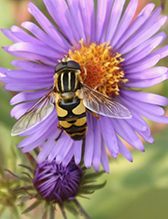 |
Luciearl |
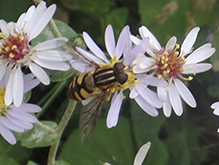 |
Bee on aster |
MinnesotaSeasons.com Photos |
||
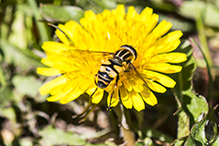 |
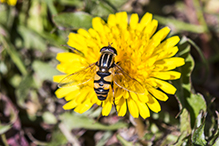 |
|
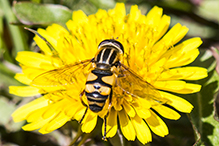 |
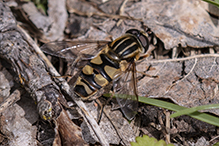 |
|
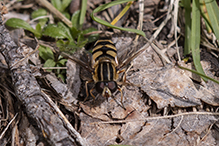 |
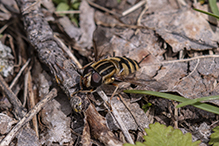 |

Visitor Videos |
||
Share your video of this insect. |
||
This button not working for you? |
||
|
Other Videos |
||
Mosca/abeja (Helophilus fasciatus) |
About
Published on Sep 29, 2012 Orden Diptera (moscas) Helophilus fasciatus es una especie de mosca que imita a las abejas o avispas, tanto en coloración como en comportamiento. Se alimentan sólo con polen y néctar. Estaba sobre una planta de lantana en los Jardines del Río Turia, Valencia. Feeding only on pollen and nectar, Helophilus fasciatus is a species of hover fly that mimics bees or wasps in both coloration and behavior. |
Hover Fly (Syrphidae: Helophilus fasciatus) Grooming |
About
Uploaded on Apr 21, 2010 Warmed by the late afternoon sun, this hover fly gives itself a thorough grooming. Photographed at Grand Forks, North Dakota (20 April 2010). Thank you to Bastiann for the identification (@Syrphidae.com)! |
Syrphid Fly - November 6, 2013 |
About
Published on Nov 6, 2013 Syrphid Fly (Helophilus fasciatus), Nectaring Sheffield Pink Chrysanthemum, Butterfly Garden, Gagnon Wildlife Habitat, Pottersville, Somerset, Massachusetts, Wednesday afternoon, November 6, 2013, 1:17 PM - Canon PowerShot SX50 HS MVI_56062; 33 min. |
Hover Fly (Syrphidae: Helophilus fasciatus) Female Ovipositing |
About
Uploaded on Jul 25, 2010 Photographed at Grand Forks, North Dakota (25 July 2010). |
Hover Fly (Syrphidae: Helophilus fasciatus) Grooming |
About
Uploaded on Apr 25, 2010 Showing an oblique view of a Syrphid fly grooming. Photographed at Grand Forks, North Dakota (24 April 2010). Thank you to Bastiann for the identification (@Syrphidae.com)! |

Visitor Sightings |
||
Report a sighting of this insect. |
||
This button not working for you? |
||
Bobbi Johnson |
Location: Silver Bay, MN … from the garden |
 |
Shelly |
Location: Eldridge, Iowa |
| KatyMN12 9/14/2020 |
Location: Lake Elmo Park Reserve |
 |
| Luciearl 9/6/2020 |
Location: Cass County Bee on aster |
 |
Jude Marion |
Location: Coon rapids, MN |
MinnesotaSeasons.com Sightings |
||

Created: 8/27/2015 Last Updated: © MinnesotaSeasons.com. All rights reserved. |
